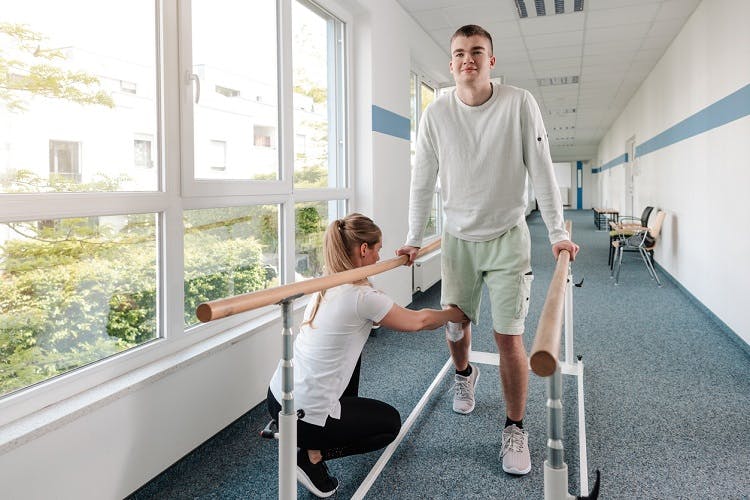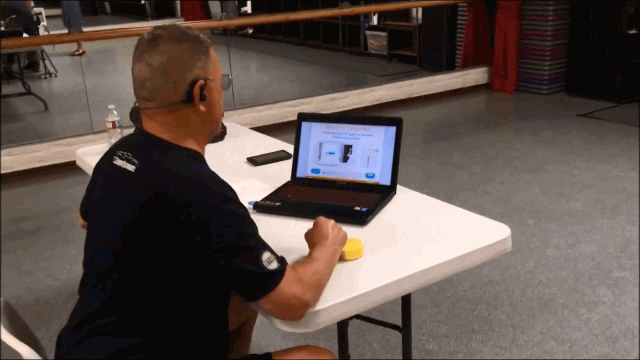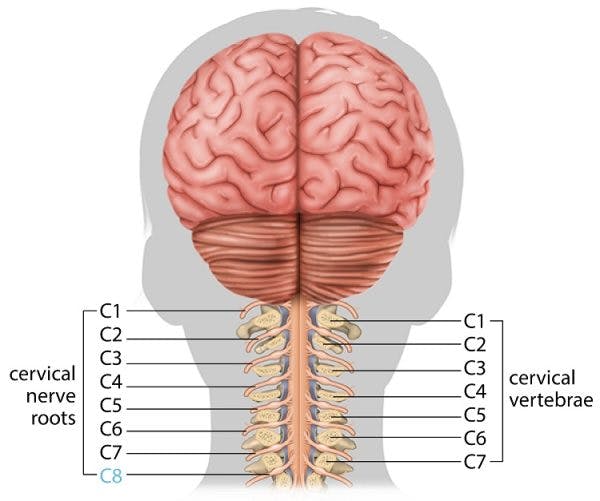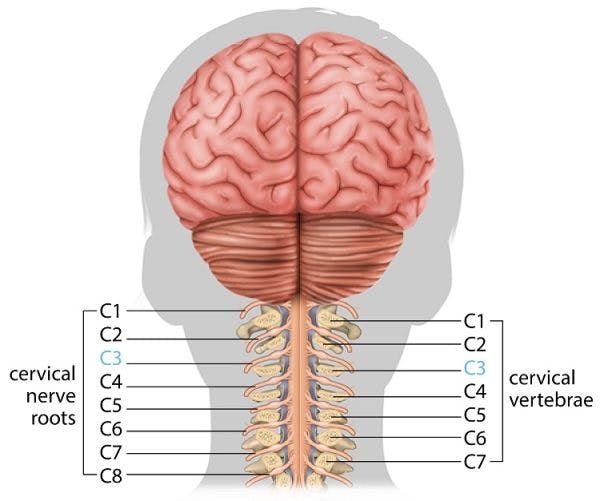While there are some generalizations about spinal cord injury recovery time, it’s important to understand that everyone experiences recovery a little differently.
There’s a common misconception that people only have a certain amount of time after their spinal cord injury (SCI) to recover and after that, they’re as good as they’re ever going to get. To debunk that myth and help you understand that recovery can occur years after SCI, this article will discuss:
Understanding Spinal Cord Injury Recovery Time
Because every spinal cord injury and its recovery process are unique, it’s difficult to give an exact time frame for recovery. However, research shows that the most recovery occurs within the first 3-6 months after spinal cord injury.
This is because immediately after spinal cord injury, the central nervous system goes through a period of heightened neuroplasticity. Neuroplasticity is the central nervous system’s ability to make adaptive changes and reorganize its neural circuitry based on our behaviors. It is the primary mechanism that allows individuals to recover functions affected by spinal cord injury.
As a result, it is often easier for the spinal cord to make adaptive changes and relearn affected functions in the early months after injury.
However, not all spinal cord injuries can recover by using neuroplasticity. Neurons in the spinal cord that are damaged beyond repair are not capable of regenerating and therefore not able to utilize neuroplasticity. As a result, recovery after spinal cord injury heavily relies on unaffected connections (neural pathways) for neuroplasticity and other adaptive changes.
The more neural pathways that remain connected through the site of injury, the greater the chances of recovery. Once your spinal cord injury is stabilized, it’s ideal to take advantage of this heightened state of plasticity and start rehabilitation as soon as possible.
However, that does not mean recovery is limited to a specific time frame. As long as you continue to stimulate the central nervous system through repetitive movement, the potential to improve is there. Individuals may continue to see improvements years after their injury.
In the following section, we’ll discuss various factors that affect spinal cord injury recovery time and how to promote recovery.
Factors That Influence Spinal Cord Injury Recovery Time
It’s important to understand that every spinal cord injury and its recovery process are unique. Various factors can affect the timing of spinal cord injury recovery.
Below, we’ll discuss several factors that may impact the rate of recovery after SCI.
Severity of Injury
The severity of a spinal cord injury plays a major role in predicting recovery time. As mentioned earlier in this article, the milder the spinal cord injury, the greater the potential for recovery. One way to classify the severity of a spinal cord injury is to determine if it is complete or incomplete.
A complete SCI refers to a lesion that completely transects the spinal cord. This leaves no neural pathways left unaffected through the site of injury. Consequently, messages between the brain and areas below the level of injury cannot be transmitted, resulting in the complete loss of motor control and sensation below the level of injury.
In contrast, an incomplete SCI refers to partial damage of the spinal cord that results in some neural pathways left unaffected by injury. Only undamaged neural pathways are capable of utilizing neuroplasticity. Therefore, to recover functions affected below your level of injury, a spinal cord injury must be incomplete.
Level of Injury
The location of your spinal cord injury also significantly impacts recovery time. The spinal cord is made up of 31 levels, each of which activates movement and receives sensory information from different areas of the body. The higher your level of injury, the more functions are likely to be affected. This occurs because signals between the brain and body cannot travel past spinal cord damage. As a result, all functions below your level of injury have the potential to be affected.
The more functions are affected by spinal cord injury, the more rehabilitation will be required because each function has to be worked on individually through targeted practice.
Secondary Complications
Secondary complications of spinal cord injury can interfere with motivation and performance. If not properly managed, they can negatively affect recovery time.
Depending on many factors such as pre-existing conditions, physical activity levels, diet, and medications, a wide range of secondary complications may be experienced.
Common secondary complications of spinal cord injury include:
- Changes in body composition may occur as a result of changes in physical activity levels. Often, individuals are less physically active after SCI due to limited motor control or weakness. Therefore, they do not require the same amount of calories as they did when they were more physically active. Likewise, loss of bone density and muscle mass can contribute to changes in weight.
- Neurogenic bladder/ bowel refers to loss of control over the bowel and bladder muscles. As a result, individuals have an increased risk of leaking, urinary tract infections, and constipation.
- Pressure sores describe skin breakdown caused by prolonged pressure on the body. Loss of sensation after SCI can cause individuals to remain in the same position for extended periods without feeling antsy or uncomfortable. This can disrupt blood flow and cause tissue damage.
- Changes in mental health may occur due to the major lifestyle changes a spinal cord injury may require. For example, individuals may develop depression, anxiety, or post-traumatic stress disorder.
- Breathing problems can occur when control over the major breathing muscles is affected by spinal cord injury. Consequently, individuals may struggle to speak or eat and have an increased risk of developing respiratory complications.
- Spasticity refers to involuntary muscle contractions caused by disrupted communication between the brain and muscles. It can restrict range of motion and be a major source of pain after SCI.
- Autonomic dysreflexia is a condition characterized by hyperreactivity of the autonomic nervous system when stimulated below the level of injury. The autonomic nervous system is responsible for regulating involuntary body functions such as blood pressure, heart rate, and body temperature. Most commonly, individuals experience a spike in blood pressure and severe headaches.
Because of the potential effects that secondary complications can have on your recovery, it’s essential to be alert for early signs and seek treatment as soon as possible.
How to Promote a Quicker Recovery After Spinal Cord Injury

Spinal cord injury recovery heavily relies on retraining your muscles, spinal cord, peripheral nerves, and brain to work in sync again. While there’s currently no cure for spinal cord injury, it is possible to recover affected functions.
Spinal cord injury recovery is all about promoting neuroplasticity, and the most effective way to do so is through massed practice. Continuously practicing movements weakened by the injury stimulates the central nervous system and reinforces demand for those functions. Ultimately, the more you practice, the better the central nervous system gets at making adaptive changes.
Below are 4 ways to promote quicker recovery after spinal cord injury.
1) Seek Early Intervention
Early stabilization of spinal cord injury is essential for minimizing damage. The longer the spinal cord is compressed, the more damage from secondary processes can occur. By seeking immediate medical attention following a spinal cord injury, individuals can significantly reduce overall damage to the spinal cord and cut down on recovery time.
2) Participate in Rehabilitative Therapies
Every spinal cord injury and recovery process is unique. Therefore, a personalized approach to rehabilitation that addresses the specific needs of each individual is ideal.
Rehabilitative therapy for spinal cord injury recovery typically consists of physical and occupational therapy (and possibly speech therapy). Professionals will assess your functional abilities and create a personalized rehabilitation plan.
Your physical therapist will help you build strength, flexibility, and balance through targeted exercise. Even if you have no motor control at all, physical therapy can be beneficial. For example, a PT may help you perform passive range of motion exercises. These are exercises that do not require energy exertion. Instead, the therapist moves your limbs for you to maintain full range of motion, promote circulation, and stimulate the spinal cord.
Additional forms of exercise that a physical therapist may recommend include:
- Stretching
- Strength training
- Aerobic exercises
- Range of motion exercises
- Aquatic therapy
- Gait training
In contrast, occupational therapy works on strengthening your functional abilities through a more practical approach. It focuses on practicing activities of daily living such as bathing, grooming, and feeding to ease the transition back to everyday life. This type of rehabilitative therapy can be highly motivating because the activities have direct, real-world applications.
Occupational therapy can also involve teaching you how to use adaptive tools and equipment like wheelchairs, universal cuffs, and reachers to help you become more independent.
By participating in intensive rehabilitative therapies, individuals can safely and effectively promote neuroplasticity.
3) Practice at Home
While rehabilitative therapies are effective, the best way to speed up your recovery is to make sure that you’re also practicing the exercises and activities at home. This increases the overall number of repetitions you’re performing, which will ultimately promote quicker results.
Thousands of repetitions are required to promote neurological changes in the spinal cord. The limited amount of time one has in their rehabilitative therapy session is simply not enough, especially because a considerable amount of time during your physical therapy session is spent for non-therapeutic purposes such as moving equipment and setting up for the next exercise.
Therefore, unless you’re in an intensive rehabilitation program that works with you every day for hours, you must practice what you learn in therapy at home.
Many individuals find it difficult to stay motivated to perform repetitions at home. This is where investing in home neurorehabilitation devices can be helpful. For example, FitMi makes it fun and easy to get your repetitions in. It includes 40 exercises designed by physical and occupational therapists for an effective full-body workout.
4) Adjust Your Diet
What you eat matters. Your diet affects your energy levels, mood, and body composition, which are all major factors that influence motivation and performance during spinal cord injury rehabilitation.
The key to maintaining a healthy diet after spinal cord injury is consistency. Extreme changes in diet can be overwhelming and difficult to sustain. Spinal cord injury is a lifelong condition, so it’s essential to find changes you can stick to long-term.
Spinal Cord Injury Recovery Time: Key Points
Although most recovery occurs within the first 3-6 months following a spinal cord injury, recovery can continue well past that period. Consistently practicing affected movements/activities will help promote neuroplasticity.
We hope this article helped you better understand how spinal cord injury recovery works as well as the most effective ways to promote a quicker recovery.












